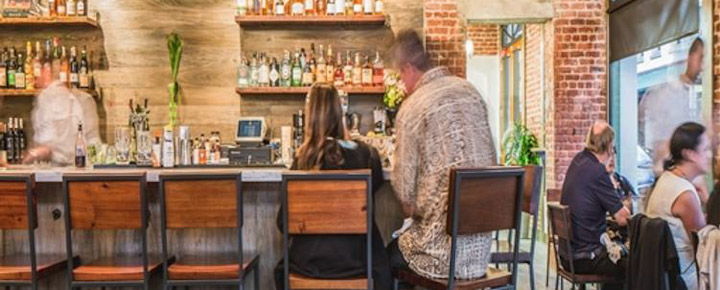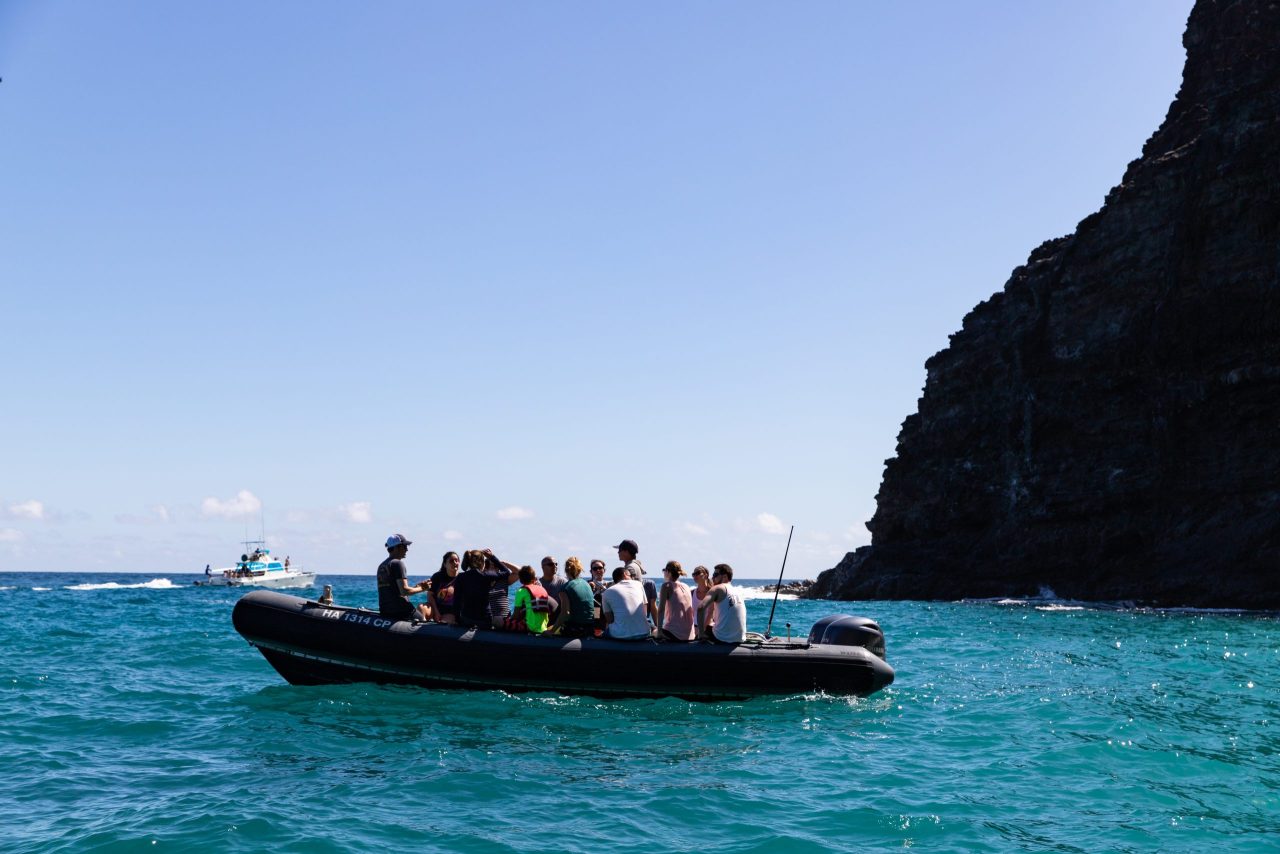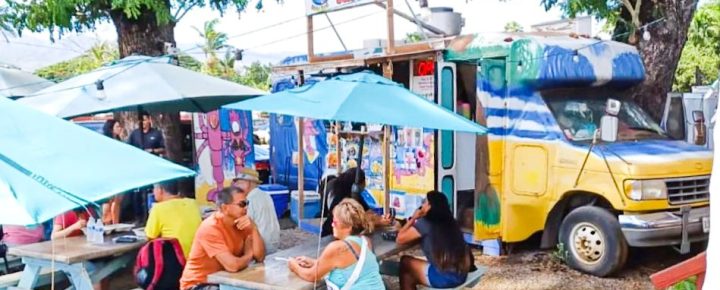Tipping is increasingly becoming a source of confusion and frustration for travelers, particularly in Hawaii, where expectations often differ from the mainland. However, as tipping culture continues to grow, with visitors expected to tip in nearly every situation, some are left wondering: has tipping shifted from being a generous act to an exploitative necessity? And who exactly is bearing the brunt of this?
For example, you choose a prepackaged sandwich from a refrigerator, and at checkout, the payment screen suggests tipping. Is the tip for the person who prepared the sandwich, the cashier who rang up the order, or shared with all employees? It’s never clear.
BOH editor Rob recently went to a coffee shop and bought a bag of whole-bean coffee to grind at home and an espresso to drink. The tip screen totaled the entire purchase and presented a combined tip suggestion of up to 30%. Rob selected a custom tip to change the percentage and only tip for the drink he had prepared. What would you have done?
It’s not just visitors who feel the pinch. For service workers, tipping often comes with emotional labor—the pressure to deliver exceptional service to make ends meet. Have business owners unfairly shifted the burden onto both their employees and customers? Some might argue that this exploitation stems directly from the practices of these businesses, leaving both groups to bear the brunt of tipping expectations.


Why tipping is different in Hawaii.
Hawaii has one of the highest costs of living in the U.S., and service industry workers often depend on tips to make ends meet. Even with Hawaii’s current minimum wage increase to $14 per hour, many argue it’s still not enough, especially in a state where housing, groceries, and basic necessities cost far more than the national average.
Tipping, in this context, is more than just a tradition; it’s a financial lifeline. One worker shared, “In Hawaii, we rely heavily on tourists being generous because every bit makes a difference in such a high-cost economy.”


Tipping at restaurants and bars.
Tipping at sit-down restaurants in Hawaii follows the mainland standard of about 20%, but with an added twist. As one frequent traveler said, “Service in Hawaii is often outstanding, and I make sure to leave more when they really go the extra mile.”
The rule of thumb at bars is to tip $1 per beer or wine and 20% for cocktails.
However, as some visitors have noted, tipping culture has extended beyond traditional services. People are now prompted to tip for takeout, counter-service, and pre-packaged drinks. “It’s feeling excessive,” one commenter shared. Am I supposed to tip for every coffee?”


Hotel tipping: bellhops, housekeeping, and valet.
Hotels in Hawaii, from budget-friendly spots to high-end resorts, have varying tipping expectations.
Bellhops generally receive up to $5 per bag, while housekeeping staff suggests tipping $5 daily at budget hotels and more for resorts. Interestingly, readers like Heather noted, “I always tip a bit more if housekeeping leaves extra towels or does something extra without me asking.”
Valet parking, which is nearly ubiquitous at Hawaii hotels, also has its tipping norms. Visitors can expect to pay $2-$5 when retrieving their vehicle, with some going beyond that when service is prompt, at higher-end properties, or under difficult conditions, like rain.


Tours, activities, and tipping fatigue.
Tour and activity providers are often integral to the Hawaii experience, and tipping reflects gratitude for their role in shaping excellent, memorable moments. Typical tips for half-day tours range from $10-$20 per person, while full-day tours can command $20-$40.
One reader shared, “I had an amazing snorkeling guide who made the whole trip unforgettable, so I left a bigger tip than usual.” Yet, as the expectation to tip extends to virtually every aspect of the tourism experience, some visitors grow more fatigued. “We’ve been asked to tip for things we wouldn’t even think about at home,” one traveler noted. “It’s getting harder to keep up.”
Transportation tipping in Hawaii.
Tipping is a standard practice in Hawaii whether you’re taking a taxi, shuttle, or ride-share. Most suggest tipping 15-20% of the fare, with a little extra if the driver helps with bags or provides local insights.
For editor Jeff, the bags make all the difference. If a taxi, Uber, or rental car shuttle driver loads and unloads bags without being asked, it’s a plus for a larger gratuity.
Airport curbside airline check-in attendants should receive $3-$5 per bag. However, for many visitors, tipping drivers is another example of Hawaii’s tipping culture pushing into areas where it wasn’t traditionally expected.
Is tipping in Hawaii becoming exploitative?
Some feel the responsibility to supplement wages has shifted disproportionately onto the consumer. As one commenter noted, “I understand tipping for good service, but when it’s everywhere, it feels like we’re being taken advantage of by business owners primarily.”
A local bartender shared, “It’s not just about doing the job anymore. We have to go above and beyond, smile more, and deal with difficult customers, knowing that our essential tip is hanging in the balance.”
Conclusion about tipping in Hawaii.
As tipping culture continues to evolve, visitors and locals grapple with its impact. Is it fair compensation for hard-working service employees, or has it become an unsustainable expectation that puts undue pressure on both patrons and workers at the hands of business owners?
The debate is ongoing, but one thing is clear: tipping in Hawaii is more than just a courtesy—it reflects the islands complex economy and the daily realities faced by those working in its thriving tourism industry.
Many visitors feel burdened by constant tipping prompts, while service workers depend on these contributions to cover living costs in one of the most expensive states. Finding a balance that supports workers without overwhelming visitors will be key to keeping Hawaii’s hospitality industry sustainable.
Get Breaking Hawaii Travel News







I’m a longtime HI visitor and now an apartment owner in Waikiki! An yes, I understand the issues related to the cost of living especially in Honolulu! In my many years of Honolulu living I am well aware of the needs of the local families depending on tips to exist! Without our generousity the local economy would default!
We have been loyal customers for many years using Hawaiian Air as our overseas transportation. It was very upsetting to see no airline signage at the LAX street curb drop off. We had to circle around the congested terminal horseshoe road to get back to the Tom Bradley Terminal B. What was a handicap section for wheelchair service in July 2024 no longer exist but fortunately the airline counter check agent was kind enough to secure a folding chair and called for handicap assistance to the gateway. Can’t Hawaiian Air place several A- frame signs; so incompetent. Tell this to the CEO
An example of employer misuse of tipping is instead of paying a liveable wage to crew and capt long term instead say that their pay is determined by tip which indicates their capability on the tour. So guests with no idea of the expectations or obstacles and are responsible for evaluating performance? That seems unfair as waves, wind, rain and the guests own sea sickness affects their tips.
I too get really cranky when getting a tip request for take out. Although if this is a small neighborhood business or I am confident the money goes to the workers then I’ll click 10 or 15%.
This article is right on that tipping is now an exploitive practice but has been so engrained in our economy. Both presidential candidates have stated a position that tips should not be taxed. On face of this, it sounds like a great deal for workers but in reality it another excuse for businesses to not pay living wages since people would be increasingly paid by tips and not taxed wages.
There is also an argument that by keeping prices lower with optional tipping allows those who are willing/able to tip more to do so and subsidize those who won’t/can’t.
Tipping also brings out and reinforces racism, sexism, xenophobia and all kinds of biases.
I had to have a mitigation company clean up a water damage in my condo in Hawaii for around to $9000. When I went to payment for it online, I was asked to tip. I was already upset that we were dealing with cleaning up all the damage the water caused ($80000 which covered multiple units) which luckily was covered by insurance, but to ask for a tip? I thought that was out of line.
I use a designated dining credit card wherever possible, but choose to give a cash tip for waiters & servers. They truly appreciate it.
Mahalo to BOH for all you do!
Go out to eat, you tip, get a prepackaged meal and leave you do not tip. Valets, tour guides, luggage handlers you
tip. If you don’t like tipping stay home and eat pbjs.
If you need to read up on how to tip on your trip, stay at home.
Thanks,
The Rest of the Planet
That’s not fair at all. So you’re saying if you’ve never been to Hawaii and you want to know what’s proper don’t bother reading about it and don’t go.
Provide no tips and force the owners of businesses to compensate their help a living wage or more. Tell the owners to cough up, raise their prices, or get out of the business. Like most of the world, we should get to a no-tip, raise-the-prices society that operates sanely and fairly.
This has gotten to a point of ridiculousness. Shall we start a movement so that workers are properly compensated and no one asks for or expects a tip?
For exceptional service well beyond the norm, a 5 to 10% tip is warranted and should be happily accepted as an out-of-the norm gratuity by workers earning $40 to $80/hour, with benefits for those working more than 15 hours per week.
Workers and consumers unite!
Aloha,
I tip when I am served. That’s what tipping is for, good service. If I go to a counter or drive thru for food, I don’t tip. I will tip if I go to Starbucks on Christmas day because I think it sucks that they are even open. I tip pizza delivery guys but I refuse to use the apps that deliver everything and want you to tip before it’s delivered. I usually tip $5 for valet and even more if I have suitcases in the car. Since Covid and hurricane damaged Caribbean islands, I have been an over tipper knowing that the shutdowns deeply affected them.
exploitative? Yes Indeed. Glad you have this article. I am from the generation that worked and worked hard. We did not have flex hours. I went to work an hour earlier and stayed late and took work home. People are coddled now and I will not be a part of it. I will not overly tip and I only tip what service is performed at restaurants. I do 20 percent now but hate every second of it, because the owners of the business Should be paying an appropriate salary. So I have decided in 2025, I will go back to 15%. I will not pay for the Greed from the wealthy any longer!
I do so little “tourist” oriented stuff when home that I rarely see the most egregious tipping situations. I patronize mostly local small businesses and the supermarkets that operate here. Don Quijote’s is my favorite. I tip generously when deserved to support local people. However, when I get poor service (rarely) or a product that does not meet my expectations I have no qualms about not leaving a tip regardless of “stink eye”. They wanna make a remark in pidgin? I can come right back in it… Don’t let yourself be pressured. The tip should equal the value of the service or product provided.
Best Regards
To add to the problem, it is becoming less common for consumers to carry cash. It’s not an issue if Venmo or Zelle is a reasonable option, but in many situations, cash is the only viable means of tipping.
I refuse to tip a cashier for doing the basics of their job when ringing up a Coke or a sandwich. That’s ridiculous.
So …
20-25% for meals/drinks
$10 for valet
$2/bag for airport shuttles
We have been coming to Kauai for years and have gotten to know a number of the longtime service people. We recognize how hard and cheerfully they work and we have no problem rewarding them for it.
Square and all the other electronic payment systems present tipping as an option everywhere, not just in Hawaii. The defaults start at 15%. Which seems ridiculous to me. What’s even more ridiculous is that you have to touch the screen to enter or deny the tip. Who wants to touch a screen that 100s of others have used. Contactless payments – HAHA, what a joke. But this is not a Hawaii phenomenon – it’s everywhere and it’s annoying everywhere. Better to pay with an app on your own phone, and avoid all of this tip Shaming.
So the bill our table of 4 is $160. We tip 20% wish comes to $ 32.
The waiter does 6 tables like ours in 1 hour. So his tip money is $192. -10% for the kitchen. So he makes $170 in our on tips.
Hm how much do I make?
I’m ok with tipping for goos service. But it is getting to much.
Tipping is a North American custom, and one I abhor. As a customer I have no say in what employees are paid, and resent being guilted into subsidizing their pay. Cruise lines are the worst offenders, routinely adding $18 or more per day, per person to your onboard account. Tipping is supposed to be optional and perhaps if more people pushed back and put down “0” , employers might get the message. Otherwise it just becomes another underhanded, but easy revenue source, and enables the employer to pay less than a living wage.
In California the prices are outrageous for everything. I’m a senior living on a fixed income. My friends and I like to go out for lunch or dinner sometimes. It has become our habit tip less than before because we can’t afford to do so. And none of us tip for anything regarding food unless we are seated at a table and someone serves us. I was in Malaysia and Singapore and tips are Not done there. You know the price of everything and no tips are ever expected. In fact, it’s considered an insult to tip. So, I got in a taxi at the airport, asked for the price to my hotel and gave exactly that and the driver was so happy. In restaurants it was great to just give the price of the listed meal. I wish it were that way here.
Good article But I don’t find the tipping culture in Hawaii to be any more exploitive than any other place in the U.S. It is out of hand.
Aloha,
As regular visitors we always tip well for services, tours, valets etc…But on our last trip there was even a “tip jar” at a grocery check stand. Thats a hard no for us. I actually laughed at first and then thanked them nicely for taking my money for the groceries I had put in cart, I had put on counter and then I put in my canvas bag. Tip fatigue is a real.
I no longer use a credit card
I pay in cash
I tip in cash
LaRa
Take-outs; I order, get my food/drink 1st, check it out(not if got plenty, if consistent), & if got time taste it, then tip. I used to tip upfront; I got cold hamburger, over cook fries, sour orange juice, smaller then normal fish pattie, hard brownie, little cheese on extra cheese pizza. Why am I tipping upfront? Only to have paid more for mediocre food & sometimes service. I’ve notice, many times when I do leave tip, there’s no Thank You. Saying Thank you is not expected, its just common courtesy-gratefulness reciprocated. I work hard for my $ to. My mom waitressed, she smiled, was friendly & on it. She liked her job, and that’s another thing, many don’t like their job, it shows in service & just because of an industry standard, they still get tipped. Employers: pay your employees a decent wage/salary. Employees: work in a job you like, serve customers good product & provide service to commensurate the wage/salary & tip! Aloha!
LaRa my sister who was a single mother worked low paying waitress jobs all her life. She was simply the best at her job. People always requested her tables. She struggled for years to make ends meet. One of her customers left her his million+ house when he died. You just never know about life and what could happen to you. She is enjoying life now with no worries. Aloha
Debra, that’s wonderful what happened to your Sister, hopefully she’s enjoying her life that’s provided such an amazing gesture. I have known several waitresses over the course of my lifetime that are similar to your Sister, they do their jobs exquisitely. Today, for some reason, some don’t understand, or care to, the customer service portion of the job. Slamming a plate 🍽 on a table doesn’t cut it. You never know who that person, or people, may be. Think of your job as more than a position, and more as a Profession! Be the Best that you can be.
Hi Ernie. I totally agree with your post. People should not even consider a job in hospitality, if they can’t be of the mind set that it takes to deal with all types of people. I was worked retail grocery for 35 yrs and believe me, that was a challenging job. The customer is always right. Even when they’re wrong. I am working harder now being retired. So much for the Golden Years that I looked forward to while I was dutifully grinding away putting in my 40 hr week. One more yr to go to collect Soc. security. Hope I make it and that it is still available to collect. Aloha. Thanks Rob+ Jeff for all of your fine updates.
Hi Debra.
Thank you for more than 200 comments. Much appreciated.
Aloha.
It does feel that tipping is becoming overly pervasive. And 20% of a total bill can be a Lot, depending on the bill. My rule of thumb is to always tip 20% If the service warrants. If the wait staff never returns after delivering my meal to ask if everything is alright, or never refills my drink (iced tea), then the amount of the tip will be reduced a bit. If they are rude or dismissive, that tip may go away entirely; but it has been a long time since I encountered rudeness.
Marina, I don’t eat out often, never really did, and I do appreciate that the Server’s job can be stressful at times. I, as you do, expect certain things, and without attitude. I rarely have encountered rudeness or unprofessional conduct, that’s not to say never. In those few times I have left a especially reserved tip, one cent! Tipping has gotten out of hand, expecting one is arrogance. Give good service with a smile and some cheerfulness and the tips will reflect it. Businesses aren’t taking care of their employees well yet except them to bend over backwards to please the customers. Living off of a paltry paycheck and supplementing it with their tips in order to barely make it isn’t right. It used to be where the tips were put away to pay for special things, Christmas Gifts, a Vacation, and even an Emergency. Today, Businesses are doing quite well, the Employees are scrounging behind seat cushions for anything that they can find. Tipping for everything is an Abuse!
It’s not unique to Hawaii. I’m a local boy now living in the Northeast, and it’s just as pervasive here. Unless it’s a self-checkout asking for a tip, I usually give Something, depending on how much “service” actually occurred.
My problem with tipping culture is that it’s just a cover for substandard wages that is pervasive in all service industry jobs – yet people aren’t willing to pay the corresponding higher costs if people were actually paid enough. So what is society to do?
I refuse to tip on taxes. I will tip for service, but when the machine wants an 18% tip that includes the taxes to the state – I say no. I do a custom tip on food/service only. I do not tip on merchandise purchased at, as an example, Cracker Barrel or similar. My mother depended on tips back in the 1950’s, so I realize how hard people work for their tips. I always tip servers.
Your article is fine. The anecdotes are fine. All sounds accurate.
But as for the general topic of tipping, I am beyond done with it. Sick of it. Tipping in the United States is exploitive, mind-numbingly stupid, and a greedy rippff. It’s designed to shame, guilt, and coerce United States’ consumers into coughing up currency. Worse, out-of-control tipping provides a path to pad bills with other duplicitous fees, as someone else noted.
More people are avoiding this stupidity. It’s why more restaurants are struggling and going bankrupt. It’s why some of us, when we can, avoid any product or service with ridiculous expected tips. Coffee? I’ll make it at home. Food delivery? I’ll get it myself.
The United States stands alone with this idiocy. None of this goes on in many modern economies, including Japan, Asia, most countries in Europe, big South American countries like Brazil, China, and on and on. Tipping in the United States? A massive ripoff. And we know it.
We were in Kauai recently at a timeshare for 3 weeks. Timeshares don’t get daily room service, but a mis-week tidy and a full clean after a week. That’s all we need. If I’m in the room when the housekeeping people come, I tip them them. If not, I leave an envelope for them and hope they share. I think their salaries are low, they are always gracious and hard-working, and it gives me pleasure to do it.
We always tip for meals, usually 20%, more if something was exceptional. But if I bought a coffee at a shop, I would likely tip less.
Tipping in the United States has always been an anomaly. Virtually nowhere else in the world do employers ask consumers to subsidize their employees’ wages. It’s now out of control and needs to change. Call it late-stage capitalism, call it exploitative, call it abuse, call it pathetically poor management, but it needs to change.
Drew, a waiter or waitress typically only makes the minimum wage, not the one that applies to everyone but somewhere around $2.85 an hour. I made more than that per hour at my first job at a Convenience Store in 1976. It’s well past the time that Businesses are required to pay wait staff at least the Regular Minimum Wage, to begin the job inexperienced, and Increase the Pay once they know it. Let them keep their tips too. They are The Faces of Your Business and Perform Customer Service Too! As some have experienced, they can easily Make or Break a Business!
Great article. Clearly gave some good tipping guidance. As for myself, I’ve been blessed so I bless others. That’s my motto.
I find that Tipping is important to the server as well as many others, if you give exceptional service, or go out of your way to help, you’re going to be rewarded. For Takeout Food, I typically leave a tip. Even if it’s the owner of a small business I will leave a tip, they provide something that I desire. Cabs, ride share, etc., certainly. For a prepackaged Food Item, Soda, Water, Chips, or even Milk… Highly Doubtful. At some point you must draw a line not to tip, I take certain things on a case by case basis. Businesses should take much of the Blame for their Unwillingness to Enumerate Employees Adequately. Hawaii faces many of the same problems as the rest of the Country, believe it or not. It’s just the structure of price differences, Everyone is Struggling! Welcome to the New Normal, hopefully it can End Soon!
I have no problem tipping for the service I receive and tend to be generous for those going beyond with extra smiles and care. What I’d like BOH to do is investigate the minivan mafia at the HNL airport that exploits travelers with trips to Waikiki. The routes often involve circuitous routing that adds extra to fare and then on arrival you will here – no credit card machine working – need cash! Learned long ago … be safe and in the know – take Uber!
A well-known tactic in Las Vegas. It’s called “long hauling”; look it up and you’ll see literally thousands of complaints about this fraud. The Las Vegas taxi driver will say the freeway is “quicker,” but what the driver is actually doing is looping you on the 15, or the 215, to greatly pad the bill — the “long haul.”
It’s so well-known, and happens so often, many millions of people religiously avoid Las Vegas taxis to and from Harry Reid airport. Happened to us while staying at the Wynn. A six-minute trip down Paradise Road — a straight shot right to the airport — suddenly had us on freeways, a blatantly obvious fraud.
I personally feel that the consumer is being taken advantage of. I have never had a problem with tipping for services provided. Now we’re pressured into tipping when you pick up a ‘to go’ order. I paid for the food and the business should be paying the employee who put the order together. I believe that business owners have passed the onus for employee ‘living wage increases” onto the customers. Another new added pressure, is when you are at the checkout in many large stores, and you’re asked to donate to all kinds of organizations, functions, etc. I donate on my own, so why don’t large corporations donate from their own pockets?
I don’t think this is unique to Hawaii. All the electronic payment terminals I encounter at any kind of food business across the entire United States seem to have the tip screen. And tip workers everywhere are in the same position, although I get the cost of living issue is generally much, much greater in Hawaii.
I get more frustrated with the Kamaina discount. The only place in the world I have traveled were residents pay one price and visitors another.
Bobby, you’re absolutely right, however I have received the discount several times because they said that I was nice. I have never asked for it nor acted any special way, I am typically nice I guess!
Floridians get discounts at DisneyWorld (at least for season passes) I know places in Las Vegas that get local discounts. It’s not that uncommon in tourist destinations, but of course, it’s not broadcast to the world.
What does that have to do with tipping? Discounts are not tips nor have anything to do with tipping.
Several months ago, I tried a walk-up burger stand in Kahului, Maui (formerly an A & W). While I was paying with my credit card, a screen popped up to add a tip. The choices were 15%, 20%, or 25%. I could not find an option to skip tipping, and there was a line of people waiting behind me. I tipped 15% and vowed to never return.
A cashier handing me a bag of food does not warrant a tip for a few seconds of “service”. For business owners, this type of extortion drives away customers.
Hmmmm,
I never seen one of these screens without the “no tip” or “custom tip” option, although sometimes the type font is tiny and easy to miss.
I think most owners figure they need to let the employees have the tip button to keep them happy, especially if all the other burger joints are doing it (which I have no idea – but L&l BBQ does it)
David, it helps the business owner keep track of the tips so that they can Tax it as Income. I have rarely ever left a tip through the table top screen, I call the Server over and discreetly hand over Cash. Unreportable, not Taxed, and it goes a lot further with no waiting until payday. BTW… I have encountered them with an option for “No Tip” and also an option for adding a Dollar Amount. I guess some places are behind the Greedy Times!
Tipping is OOC all over the US, not just Hawaii. Rob’s coffee shop example could be any coffee shop. I ducked into a brewery-restaurant in California last weekend, just to buy some beer from the takeaway cooler. Just like your sandwich example. I grab the beer from the fridge, walk it over to the cashier, and I get the bill in an envelope with tip request. And, I’ve had that pre-made sandwich example recently at a grab n go in an airport terminal. I’m surprised supermarket checkers aren’t asking for a percentage of your grocery bill. People do it because it works.
Being a year round resident on Kauai, I am not immune to the tipping request at checkout at all sorts of stores. I generally tap”No Tip”, as I am put off by the request. Dining out, rarely done, is different. I am subject to the high cost of living, I am retired, yet have a part-time job, and I donot receive tips for my efforts. I receive commisions from my employer. I feel that tipping culture has gone too far!
On a Sept. trip to Maui, I went to a couple of Merriman restaurants. I was surprised by an added “kitchen fee” in addition to the expected tip. It was nowhere noted on the menu but there it was added to the bill as if it were a mandatory tax. It wasn’t large but annoyed me. What’s next: a lease fee? a laundry fee? an insurance fee? One would think that the implied contract of offering an entree for $55 is the amount that will cover the cost of goods and service for the restaurant owner. If not, raise the frickin’ price.
New Zealand has it right. Here’s the menu with the price of the meal. No tip. No fee. No surprises.
Don’t be surprised when they introduce pay toilets at restaurants and places like Costco, Macy’s etc.
John, maybe the next line item Fee will be for the Garbage Hauler or the Accountant. If they can add one on, however small, for the kitchen staff anything is possible. BTW… what about a Fee for Cleaning the Grease Trap! Businesses are beginning to have no Shame.
Ever since COVID, tipping culture has gone off the rails. It’s not just the sky-high percentages but also the phenomenon of “tip creep” — where you’re now guilted into tipping for takeout or for services that never used to expect a tip.
And here in CA, restaurants have gotten sneakier with their fees, tacking on charges like “employee healthcare” or “fair living supplement” — basically just creative ways to pad the bill.
Then there’s the new trend where you don’t even get a chance to see your check. The waiter rolls up with a card machine and you’re hit with a pre-programmed tip selection: 25%, 20%, or 18% — no pressure, right?
Oh, and the cherry on top? Service has tanked. A few years back, waiters would at least check in throughout the meal. Now, even at expensive spots, you get your drink, your food, and then poof — they disappear until it’s time to drop the $200 check for two people.
Mark, I know many people suffered during the Covid times, afterwards something certainly has changed and not for the better. Everything is out of control! The Minimum Wage was established as a “Beginning/Training Wage” and never intended to support a Family of however many, but suddenly it was. Instead of High School students and recent Graduates using it as a stepping stone, Adults are forced to use it as their Primary Source of Income. The Businesses that do this should be Boycotted, they are making increasing profits due to this. Covid is long in the past, it’s time to move on. Despite some States raising their minimum wage by almost double, the workforce is in worse trouble, the economy sucks and prices more than doubled putting most in a deficit spending on just essentials, if they can afford it. This current Administration is to Blame! I just Pray 🙏 that things get Much Better, Soon.